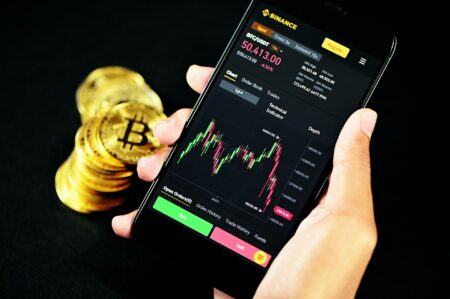Earlier today, Arthur Hayes, Co-Founder of 100x Group, published an essay on what the U.S. Federal Reserve is likely to do in 2022, how that will affect crypto prices, and how he has adjusted his personal crypto portfolio in preparation for this.
100x Group, which came into existence in July 2020, is the holding group for HDR Global Trading Limited, which is the owner and operator of the crypto derivatives platform BitMEX. Hayes was the CEO and CTO of BitMEX until October 2020.
In a blog post titled “Maelstrom” that was published on 7 January 2022, Hayes started by talking about the total risk-asset meltdown that occurred in mid March 2020 when it bcecame clear that COVID-19 was indeed a global pandemic and potentially a very serious problem for the world economy.
Hayes wrote:
“On 16 March, Bitcoin experienced a correlation 1 moment and got clobbered — along with every other risk asset globally — as the world (ex-China) discovered the COVID-19 pandemic was real, real bad.
“A correlation 1 moment is when all risk assets fall together, as investors at the margin rush to sell anything to raise the global reserve currency (currently the US Dollar) so that they can pay back loans. Nothing is spared. Only once the dust settles and fear dissipates do assets once again begin moving in more idiosyncratic ways.“
Hayes, who believes that in any year there are “only a few trading days that actually matter”, believes that “active traders MUST be present for any and all days like 16 March” and that “reducing risk during an event like the 16th, and adding it back shortly after the puke out, is what creates stellar compounded returns.”
Furthermore, he believes in 2022 there will be “a string of trading days as disastrous as 16 March 2020” and that “as usual, this relates to the Fed reducing the growth of their balance sheet to 0%, and subsequently raising rates one to three times in 2022.”
Hayes then talked about how the Fed expanding and shrinking its balance sheet affects the price of Bitcoin (and thereby the whole of the crypto market).
Here is how St. Louis Fed defines M2:
“M2 is a measure of the U.S. money stock that includes M1 (currency and coins held by the non-bank public, checkable deposits, and travelers’ checks) plus savings deposits (including money market deposit accounts), small time deposits under $100,000, and shares in retail money market mutual funds.“
Hayes stated:
“The loose US monetary conditions definitely influenced the meteoric rise in price (albeit a few months delayed). Since M2% growth stalled, Bitcoin has traded sideways. If M2 is set to hit 0% — and possibly even go negative — in short order, the natural conclusion is that Bitcoin (absent any asymptotic growth in the number of users or transactions processed via the network) is likely to go much lower as well.“
The extent of Fed’s hawkish mood, which was revealed following Wednesday’s release of the minutes of the FOMC meeting held in December 14-15, 2021, is why Hayes expects the Bitcoin price to go “much lower”.
Here is what prominent macro-economist and crypto analyst Alex Krüger said yesterday on Twittter:
The former BitMEX CEO believes that central bankers’ current focus on inflation means that we are going to see them temporarily “unwind their balance sheets”:
“The villagers woke up because the cost of meat, veggies, a taxi ride, rents, and other essentials is rising faster than their wages. Now they are trained on Public Enemy №1 — inflation. If domestic politicians worldwide want to keep riding the gravy train, they have to pretend to do something.
“Therefore, it’s time for central bankers to put on some kabuki theatre and, at least for a short while, pretend like they are willing to unwind their balance sheets and return to positive interest rates that reflect the reality of various domestic economies.“
Hayes then went on to say that he considers $BTC and $ETH to be the only true benchmark cryptoassets and that every token is “trying to be a better version of Bitcoin or Ethereum, or it is leveraging the features of either network to create a new product or service.”
Here is how Hayes has recently restructured his personal crypto portfolio:
“I went through my entire crypto portfolio. After a 75% drop from the current levels, any shitcoin I wouldn’t increase my position in, I dumped. That left me with Bitcoin, Ether, and a few other large positions in metaverse and algorithmic, stablecoin-related tokens.“
And he is now waiting with enough “fiat dry powder” to be ready for the “capitulation” candles that he expects to see later this year as the Fed takes action to bring down inflation in the U.S.:
“Armed with fiat dry powder, I stand ready for the capitulation candle. I’ve been trading these markets long enough to spot the last-gasp, puke-out candle that breaks the soul of the speculative bulls.
“Even though I’m confident in my abilities to spot a bottom, I learned the hard way not to try and catch a falling knife. So what if you don’t bottom-tick the market? Let the market heal, and buy it higher with more confidence that the marginal paper handed seller is finished.”
DISCLAIMER
The views and opinions expressed by the author, or any people mentioned in this article, are for informational purposes only, and they do not constitute financial, investment, or other advice. Investing in or trading cryptoassets comes with a risk of financial loss.
IMAGE CREDIT
Featured Image by “geralt” via Pixabay







